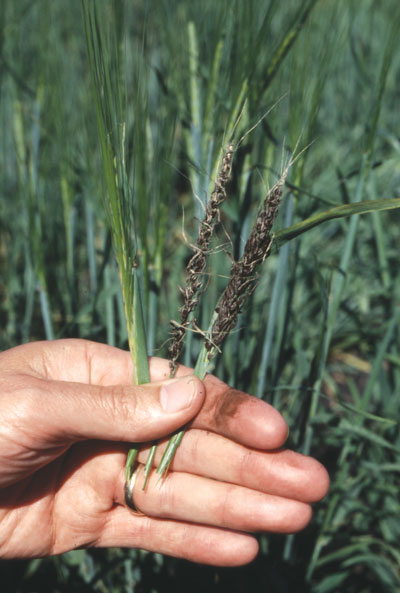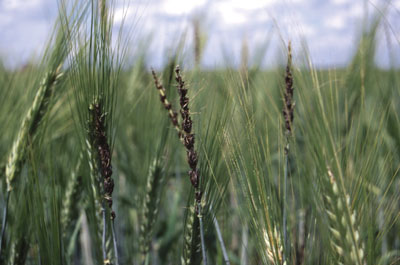
Features
Agronomy
Diseases
Bunt and smut control requires vigilance
Out of sight, out of mind.
April 30, 2010 By Bruce Barker
Out of sight, out of mind.
 |
|
| Choose resistant varieties and use seed treatments to control loose smut. (Photos courtesy of Mike Shillinglaw, Agriculture and Agri-Food Canada) |
|
 |
|
| Growers need to pay attention to loose smuts (shown) and bunts to keep them under control. |
Bunts and smuts have been under control in Western Canada since the mid-1900s, but that does not mean complacency is in order. Historically in North America, bunts and smuts were the most severe diseases in wheat and barley by far. No other disease came close. In the late 1800s, in Manitoba and Saskatchewan, it was estimated that farmers lost 20 to 30 percent of their cereal crops to these two diseases, with some losses as high as 75 to 90 percent. “What has changed is we can now control them. So if we stop thinking about these diseases, and stop trying to control them, they can come back and bite you in the pocketbook where it hurts the most,” says plant pathologist Jim Menzies with Agriculture and Agri-Food Canada at Winnipeg, Manitoba.
Despite the control methods available, which include seed treatments, crop rotation, and varietal disease resistance, the diseases still persist on the Prairies. Menzies explains that a disease survey is conducted for loose smut every year in Manitoba and Saskatchewan, and it is found in 20 to 40 percent of wheat fields. The infection level, though, is usually fairly low, but has reached five to 10 percent several times over the last 15 years.
In durum wheat, the loose smut incidence is much higher at 40 to 70 percent, but the infection level is usually very low. Menzies says that low infection levels are related to environmental factors because durum wheat does not have good resistant to smuts. “If you want to grow durum outside the traditional drier areas, loose smut could become an issue,” says Menzies.
In barley, six-row types are not as resistant as two-row types to loose smut. The loose smut incidence levels are usually in the 40 to 80 percent range for six-row barley. Menzies explains that most six-row barley is grown for feed and is viewed as a low-value crop. As a result, bin-run seed is often used for many years, and then suddenly there is a problem with loose smut. “Loose smut yield loss has a direct correlation to infection. Percent infection equals percent yield loss,” says Menzies.
Two-row barley has much better varietal resistance to loose smut, but the incidence levels are still in the 20 to 30 percent range. In the surveys, the highest loose smut infection levels for six-row barley have hit 25 percent over the last 15 years, but two-row barley has much lower levels, around one percent. “We only report what is on surveys but we frequently get calls with infection levels from 25 to 30 percent,” says Menzies. “This is a disease where we should not be losing anything. It is easily controlled.”
Bunt on wheat is also found on the Prairies, although exact figures are not available. “We do know a few railcars are turned away from Thunder Bay and Vancouver each year because it smells like fish. It has bunt. So it is there and is something that can come back to hurt you,” says Menzies.
A disease primer
Loose smut is caused by different species of ustilago, depending on the host (barley or wheat). Infection occurs during flowering but does not affect the seed’s appearance or quality at harvest. Rather, the ustilago mycelium remains dormant in the seed until it is planted, when it attacks the growing point of the seedling.
Conditions that favour loose smut are cool moist weather during flowering with 95 percent relative humidity and 20 to 25 degrees C. The longer the flowering, the better conditions for the disease. Durum wheat does not suffer much damage from loose smut because it is typically grown in dry areas that are detrimental to the smut’s development with excessive heat and dry weather during flowering.
Common bunt or stinking smut is caused by Tilletia laevis and T. tritici. Bunt affects wheat, rye, triticale and other grasses, and replaces developing kernels with spore-filled bunt balls. These spores are a source of infection in contaminated seed, but may be controlled with a seed treatment
Common bunt likes cool soil temperatures between five and 10 degrees C and deeper seeding, where the soil is cooler. Bunt symptoms are very hard to find in a field. The first noticeable symptom is usually a fishy smell at harvest.
Simple, effective control practices
Many control practices are the same for loose smut and common bunt. Use resistant varieties when available. Wheat, barley and oats have resistant varieties readily available. The provincial variety guides have ratings for disease resistance and should be used to guide selection for disease resistance. “There are some good ones but also some dogs for resistance. If you look at loose smut, most of the barley lines have very poor or poor resistance. And if you use these lines, the disease will build up,” says Menzies. “If you have a choice, pick one with resistance to the diseases.”
In oats, most of the varieties have very good resistance to seedling-infecting smuts, and all hulless oat varieties have very good resistance. This is why seedling smuts are not common in oat crops.
In wheat, varietal resistance to smuts and bunt is quite variable.
Seed treatment fungicides are highly effective and should be another control cornerstone. Systemic fungicides are necessary for loose smut of wheat and barley. The fungicide has to get inside the seedling to control the fungus.
Contact or protectant seed treatments are very effective for bunt and the seedling-infecting smuts. With these diseases, the fungicide kills the spores on the outside of the seed.
There are several registered fungicides on the market, but Menzies cautions that loose smut fungi resistant to carbathiin (Group 7), the active ingredient in Vitaflo, have been found in Western Canada. “The resistance is not very common, and I wouldn’t recommend getting rid of carbathiin. It is a very effective fungicide,” says Menzies. “For all fungicides, they should be used in a fungicide rotation. If you want to prevent resistance, you should use a different mode of action every year, and you will prevent resistance and get effective control of the smuts.”
Certified seed has extremely low levels of these pathogens and is recommended as a seed source since disease-free seed is an effective way to eliminate the disease.
For bunts, crop rotations can also help reduce spore loads. The bunt spores can survive in the soil for one to two years, so keeping wheat out of the rotation for several years will reduce the disease levels. “People ask me why I work on these diseases that are diseases of the past?” says Menzies. “I can say that they are only diseases of the past because we have developed good control techniques, and if we stop working on these techniques, they will no longer be diseases of the past. And even now, without attention to control methods, they have been found to be a disease of the present.”